Voigtländer Large Format Lenses from 1949-1972 - Lens-Club
Voigtländer Large Format Lenses from 1949-1972 - Lens-Club
Voigtländer Large Format Lenses from 1949-1972 - Lens-Club
You also want an ePaper? Increase the reach of your titles
YUMPU automatically turns print PDFs into web optimized ePapers that Google loves.
<strong>Voigtländer</strong> <strong>Large</strong> <strong>Format</strong> <strong><strong>Lens</strong>es</strong> <strong>from</strong> <strong>1949</strong>-<strong>1972</strong><br />
© 2005 - 2012 Arne Cröll – All Rights Reserved (this version is <strong>from</strong> November 17, 2012, the<br />
first version of this article appeared in “View Camera” May/June 2005<br />
The <strong>Voigtländer</strong> companies - a short historic overview<br />
Although it has been about 40 years since the last LF lenses left the <strong>Voigtländer</strong> plant in<br />
Braunschweig (Brunswick), Germany, the company name is still well known in the LF<br />
community. Many of the lenses, especially those made after WWII, are still in use and are highly<br />
regarded. One reason is certainly that the <strong>Voigtländer</strong> company was one of the oldest<br />
manufacturers in the field, having made LF lenses for 132 years, but there is also a certain<br />
mystique about the lenses – as an old advertisement slogan for the company’s cameras said: “A<br />
<strong>Voigtländer</strong>, because the lens is so good!”.<br />
The company name <strong>Voigtländer</strong> 1 is much older than photography. In 1756, Johann<br />
Christoph <strong>Voigtländer</strong> founded a mechanical shop in Vienna, Austria, making compasses and<br />
other mechanical instruments. In 1807, his youngest son Johann Friedrich <strong>Voigtländer</strong> founded<br />
his own optical and mechanical shop, also in Vienna, adding eyeglasses and other optical<br />
instruments to the line. The company was famous for their opera glasses, introduced in 1823.<br />
Johann Friedrich retired in 1837 and the company was headed next by his son Peter Wilhelm<br />
Friedrich <strong>Voigtländer</strong>. Shortly after the Daguerreotype process was announced in 1839, he<br />
started to cooperate with the Viennese mathematician Joseph Petzval, resulting in the first lens<br />
designed purely through mathematical calculations, the famous f/3.7 Petzval portrait lens. In<br />
1849 Peter Wilhelm Friedrich <strong>Voigtländer</strong> founded a second shop in Braunschweig, Germany,<br />
the home of his forefathers, which subsequently became the company headquarters. The<br />
Viennese shop was closed in 1868, while the factory in Braunschweig remained for more than<br />
100 years. In 1876, Peter Wilhelm Friedrich <strong>Voigtländer</strong> was succeeded by his son, Friedrich<br />
Ritter von <strong>Voigtländer</strong>, who converted <strong>Voigtländer</strong> into a stock company in 1898. After the death<br />
of Friedrich Ritter von <strong>Voigtländer</strong> in 1924, the family sold the stock to Schering, a manufacturer<br />
of chemicals and photographic papers. <strong>Voigtländer</strong> survived the WW II years without major<br />
damage and came under British control in 1945. From 1945 until the introduction of the D-<br />
Mark in <strong>1949</strong>, their production went mostly to the Allies as reparations. In 1956, Schering sold<br />
<strong>Voigtländer</strong> to the (West-German) Carl Zeiss foundation in Heidenheim, although<br />
manufacturing and sales remained separate <strong>from</strong> Zeiss until the founding of the “Zeiss-Ikon –<br />
<strong>Voigtländer</strong>” sales organization in 1966. In 1970, the <strong>Voigtländer</strong> company was dissolved and<br />
merged into Zeiss-Ikon, although LF lenses still carried the <strong>Voigtländer</strong> name. In <strong>1972</strong>, Zeiss-<br />
Ikon stopped the production of all product lines, including the <strong>Voigtländer</strong> LF lens production.<br />
The Braunschweig factory was sold to Rollei (also in Braunschweig) and renamed “Optische<br />
Werke <strong>Voigtländer</strong>”. <strong>Lens</strong> production continued with the Zeiss-licensed Rollei medium format<br />
and 35mm lenses, using a much smaller number of employees. The factory was finally closed 3<br />
years later in 1975. Rollei continued to sell products under the <strong>Voigtländer</strong> brand name until<br />
they got into financial trouble in 1981. The <strong>Voigtländer</strong> name was then sold to Plusfoto, a<br />
1 A remark on the spelling: The name is spelled <strong>Voigtländer</strong>, with the umlaut “ä” – the correct transcription into<br />
English is “Voigtlaender”, although “Voigtlander” is close. Note that there was never an “h” in the name, as in the<br />
commonly seen “Voightlander”!<br />
1
German photo retail chain. In the 1980’s, cheap 35mm cameras and lenses <strong>from</strong> Japan (Tokina,<br />
Maginon, Kiron, etc.) and Taiwan were branded with the <strong>Voigtländer</strong> name and distributed<br />
through Plusfoto. In 1997, Plusfoto merged with Ringfoto, another German retailer. A recent<br />
20-year agreement on the use of the <strong>Voigtländer</strong> name between Ringfoto and the Japanese<br />
Cosina company lead to the present “Bessa” line of 35mm and medium format rangefinder<br />
cameras and lenses. However, <strong>from</strong> the LF point of view, the history of <strong>Voigtländer</strong> ended in<br />
<strong>1972</strong>.<br />
LF lenses <strong>from</strong> 1840 to 1945<br />
The first photographic lens built by <strong>Voigtländer</strong> was the Petzval portrait lens in 1840. It was<br />
followed by the Orthoskop landscape lens, another development by Joseph Petzval. Later wellknown<br />
lenses were the Euryskop (an Aplanat/Rapid-Rectilinear type), and the anastigmatic<br />
Collinear, which was built <strong>from</strong> 1894 until the 1940’s. The Collinear lens was also sold as<br />
Orthostigmat by Steinheil in Munich (Steinheil and <strong>Voigtländer</strong> shared the patents), and was a<br />
direct competitor of the Goerz Dagor. The best-known <strong>Voigtländer</strong> lens was the Heliar,<br />
originally invented by Dr. Hans Harting for <strong>Voigtländer</strong> in 1902 [16]. It was a derivative of the<br />
Cooke triplet with cemented doublets replacing the first and third lenses. These consisted of an<br />
outer negative meniscus made <strong>from</strong> flint glass and an inner biconvex lens made <strong>from</strong> crown<br />
glass. Harting’s first design was symmetric [16], but he soon followed it with a much better<br />
corrected asymmetric one, shown in fig. 1a [17]. Later he designed a related lens [18] that<br />
turned the outer doublets around, shown in fig. 1b. This lens was called the “Dynar”. After<br />
World War I, <strong>Voigtländer</strong> continued mostly with the Dynar design, but renamed it Heliar <strong>from</strong><br />
then on. Therefore the term “Heliar-type” often refers to Harting’s 3 rd design (fig. 1b). Note that<br />
<strong>Voigtländer</strong>s literature often showed the old design (fig. 1a), even in catalogs after WW II [11],<br />
although the actual lenses used the design shown in fig. 1b. Which design is used can easily be<br />
checked by observing the reflection of a light source in the lens, especially the weak reflection of<br />
the cemented interfaces: for type 1a the cemented interfaces are convex towards the viewer,<br />
when seen <strong>from</strong> the outside, for type 1b they are concave. All post-WWII regular Heliars I have<br />
seen are of the second type.<br />
In 1921, the Heliar was improved, and an f/9 process lens version [19] as well as a<br />
portrait version with a maximum aperture of 3.5 [20] were designed by Robert Richter, who later<br />
became a designer for Goerz and subsequently for Zeiss. Other well-known LF lenses in<br />
addition to the Heliar and the Collinear were the Skopar, a well-regarded Tessar-type design, the<br />
fast (f/2.5) and somewhat soft Heliostigmat (a reversed Tessar design), the Voigtar (a simple<br />
Triplet), the Radiar (a Dialyte), and the Tele-Dynar, a 5/3 telephoto lens. Table 1 lists most<br />
lenses available for large format in the years <strong>from</strong> about 1928 to the early 1940’s; all in all more<br />
than 60 different lenses were offered.<br />
Post-WWII lenses<br />
Directly after the war, <strong>Voigtländer</strong> continued parts of the prewar program as the plant had not<br />
suffered major war damage, and introduced lens coatings soon after the war’s end (a list of serial<br />
numbers for the postwar production is given in table 2). Thus coated lenses of some prewar<br />
models that were later discontinued, do exist (e.g. f/3.5 Heliar, Skopar, etc.). Those are usually<br />
above the 2,700,000 serial number, marking the end of WWII, but not much above 3,000,000<br />
(Nov. 1947). The inscription font also changed to a cleaner, more modern one without serifs.<br />
2
From about <strong>1949</strong> on, <strong>Voigtländer</strong> discontinued many older LF lenses and introduced several<br />
new models, specifically the Apo-Lanthar, Apo-Skopar, Ultragon, and Telomar series. The only<br />
older LF lens lines to be continued were the f/4.5 Heliars and Universal-Heliars, although with a<br />
reduced number of focal lengths. Most new lenses were designed by Albrecht Wilhelm Tronnier<br />
(1902-1982), who had been a lens designer for Schneider-Kreuznach and ISCO before and<br />
during the war. At Schneider he had been responsible for several well-known lenses, including<br />
the Angulon, Xenar, and Xenon. He had his own optics design bureau in Göttingen and became<br />
a consultant to <strong>Voigtländer</strong> in 1944. He was responsible for most of their famous post-WWII<br />
lenses, including the 35mm Ultron and Nokton. After the initial flurry of new designs in the LF<br />
field, Tronnier and <strong>Voigtländer</strong> concentrated on 35mm cameras and lenses until the demise of<br />
the company in <strong>1972</strong>. However, LF lenses were manufactured and sold until the end – the last<br />
1000 LF lenses were manufactured in April <strong>1972</strong> [4]. The prewar <strong>Voigtländer</strong> LF cameras (e.g.<br />
the famous “Bergheil”) were discontinued after WWII, but one new 13x18cm (5x7”) monorail<br />
model was produced <strong>from</strong> 1950-1955. It is rare, but easily recognized by its use of large circular<br />
lensboards.<br />
There are a few peculiarities of <strong>Voigtländer</strong> LF lenses. One is the unit for the focal length<br />
inscription. Before the early 1900’s, German lens companies including <strong>Voigtländer</strong> marked the<br />
focal length in millimeters. After that time, centimeters were generally used as a unit. After<br />
WWII, most lens companies switched back to using millimeters. <strong>Voigtländer</strong> used mm<br />
designations for their 35mm and medium format lenses at that time, but for unknown reasons<br />
continued the cm designation for their large format lenses.<br />
Due to their construction (i.e. the Heliar type), most <strong>Voigtländer</strong> lenses need a rather<br />
large shutter opening in relation to the focal length, especially compared to Plasmat-type lenses<br />
like the Schneider Symmar <strong>from</strong> the same time period. Many of their shuttered lenses therefore<br />
use Compound shutters (sizes III, IV, and V), or a Compur 2. The latter is often a dial-set<br />
version, although the later rim-set version (introduced by Deckel in 1953) was also used. Only<br />
the short focal lengths (105 and 150mm Heliar/Apo-Lanthar) used rim-set Synchro-Compurs<br />
exclusively. Towards the end of production, <strong>Voigtländer</strong> offered an alternative to the<br />
Compounds, the Compur electronic shutters (nos. 3 and 5 FS) 2 , and the very last lenses used the<br />
new mechanical Compur versions (very rare). This peculiar lineup of shutters means that only<br />
the short focal lengths in Compur 1 and the late lenses in a Compur 3 can easily be transferred<br />
to current modern shutters. The Compur 2 was discontinued in the mid-late 1960’s and has<br />
unfortunately no modern equivalent. An adapter to Copal 3 is necessary to transfer lens cells to a<br />
modern shutter. The no. III Compound is different <strong>from</strong> a modern size 3 in the thread size of<br />
the lens cells (and also of the mounting thread) and thus adapters are also needed for mounting<br />
in a modern no. 3 shutter. Compounds IV and V as well as the Compur 5 FS have no modern<br />
equivalent. Fortunately, Compur and Compound shutters are usually pretty robust and when<br />
slow or stuck can be brought back to life with a good CLA. A few lenses have also been seen in<br />
Ilex shutters. Note that <strong>Voigtländer</strong> LF lenses do not have filter threads - they only take slip-on<br />
filters. Visible threads in the front mount are for the retaining rings of lens elements.<br />
2 Note that the Compur electronic 5 FS, which replaced both the Compound IV and V, is very heavy (even<br />
compared to a Compound V) and can only be used with a battery-powered external command unit to set the<br />
aperture and trip the shutter.<br />
3
<strong>Voigtländer</strong> coatings were quite good, even early ones, and are therefore usually in good shape if<br />
the lens was not abused. Only single coatings exist, as the advent of multicoating coincided with<br />
the end of production at <strong>Voigtländer</strong>. A common ailment of the lenses, however, is the<br />
separation of the cemented interfaces and it is worthwhile to check for it in a used lens. The<br />
Apo-Skopar, Apo-Lanthar, and the Telomar are especially prone to element separation.<br />
Separation shows up as colorful Newton’s rings in the lens, almost always starting at the rim. The<br />
optical correction is not really affected by this, since the separation is only a few hundred<br />
nanometers, but flare will be increased. In most cases only a few mm in the periphery are<br />
affected. Although this should not influence performance at all, it does affect the used market<br />
price.<br />
Heliar and Universal-Heliar<br />
Of the two prewar Heliar lines, <strong>Voigtländer</strong> continued only the “slower” f/4.5 versions (table 3),<br />
with a slightly reduced number of focal lengths. One source [2] claims a redesign in the early<br />
1950’s, but this is hard to verify. Officially the new “Color-Heliar” [22] was only used in the f/3.5<br />
105mm version for the “Bessa II” 6x9cm folder. Made until <strong>1972</strong>, the Heliar was one of the<br />
lenses with the longest production cycle, 70 years. Due to the design and the wide opening,<br />
Heliars have a considerable size and weight in the longer focal lengths – they are at least as big<br />
and heavier than Tessars with the same specifications (fig. 2). The coverage of most Heliars is<br />
around 58°.<br />
Both barrel and shutter versions of the Heliar were sold. There was also a third<br />
possibility: One could buy the cheaper barrel version and mount a “Zettor” external shutter on<br />
the front (fig. 3). The Zettor was made by the Zett company, owned by Erich Zillmer, also<br />
located in Braunschweig. He sold his company to <strong>Voigtländer</strong> in 1960. The version with the<br />
Zettor was offered for the 210, 240, and 300mm barrel Heliars. For the 300mm Heliar, the 1950<br />
prices in Germany were [1]: in barrel DM 560.00; in barrel with Zettor shutter DM 630.00; in<br />
Compound V shutter DM 670.00. The Zettor has only 4 settings: Closed, Open, B, and<br />
Instantaneous time. The latter time depends on how fast the cable released is pressed; in my<br />
experience about 1/8s is the fastest for the largest Zettor fitting the 300mm Heliar, but this is<br />
obviously operator dependent. With a little practice it is possible to achieve slower times like ¼<br />
or ½ s repeatedly, but the accuracy is certainly not good enough for the controlled exposure of<br />
color slides. The Zettor shutters can of course be used with other lenses having a similar front<br />
diameter.<br />
The main use of the Heliar was (and is) as a portrait lens. Used wide open the lens shows<br />
a slightly reduced contrast and resolution (by today’s standards), without being a soft focus lens<br />
like the Universal Heliar or Rodenstocks Imagon. It has always been praised for its pleasing<br />
rendering of out of focus areas (“bokeh”). Both features contribute to the “Heliar look”. The<br />
Heliar becomes gradually sharper and achieves high resolution when stopped down, and at f/16-<br />
f/22 it is indistinguishable <strong>from</strong> a modern lens.<br />
The Universal-Heliar (table 4) was a real soft focus lens, where the biconcave center<br />
element was moveable with a ring at the front of the lens to adjust the soft focus effect. In the 0<br />
position, the lens is fully corrected, without soft focus effect, for the other settings the soft focus<br />
effect increases with increasing numbers. It was only available in barrel mount. It is usually said<br />
that it is the same design as the Heliar, just adding the lens movement, but in this case it actually<br />
does use the design of Hartings original Heliar (fig. 1a) and has a smaller angle of coverage<br />
(50°). After WWII, the Universal-Heliar was produced in 3 focal lengths (300, 360, 420mm).<br />
4
Pricewise, regular Heliars used to be bargains, especially compared to the other <strong>Voigtländer</strong><br />
lenses, but since a few years prices have picked up. A 210mm lens in a Compound III that is in<br />
reasonably good condition used to be in the $200-300 range, but now often goes for twice as<br />
much. The Universal-Heliar on the other hand, is quite scarce (even scarcer than an Apo-<br />
Lanthar, see below) and therefore commands much higher prices, even though it only comes in a<br />
barrel mount.<br />
Apo-Lanthar<br />
The Apo-Lanthar (fig. 4), available in 4 focal lengths <strong>from</strong> 105-300mm (table 5), was designed<br />
and patented by A.W. Tronnier [21]. It is of the same basic construction as the Heliar, 5 lenses<br />
in 3 groups (fig. 1b), with similar coverage, but improved performance. Apo-Lanthars were made<br />
<strong>from</strong> 1954 to <strong>1972</strong>. Most Apo-Lanthars were sold in shutters; barrel mounts are rare, but do<br />
exist. The Apo-Lanthars are marked by three colored stripes around the outside chrome surface<br />
of the front cell, in red, green, and blue. This designates the “Apo” part of the name, with a<br />
considerably reduced secondary spectrum. As <strong>Voigtländer</strong> wrote in a brochure <strong>from</strong> 1967 [11]:<br />
“… -a high-performance five-element anastigmat with the remarkable speed of 4.5, fully corrected for<br />
the three main colour bands of the spectrum. Its design is based on the principles used in the<br />
apochromatic correction of process lenses. In view of its high speed the Apo-Lanthar is thus eminently<br />
suitable for shots of live subjects at fast shutter speeds. It is a universal lens in the true sense of the word,<br />
guaranteeing perfect sharpness all over the image field, maximum brilliance and contrast, as well as<br />
purity of colour rendition.”<br />
The second part of the lens name is due to the fact that the front lens is made <strong>from</strong> lanthanum<br />
crown glass. Glasses using rare earth oxides were investigated by George W. Morey in the late<br />
1920’s at the US Geophysical Laboratory and <strong>from</strong> 1931 he developed them further for Eastman<br />
Kodak. They were initially made and used by Kodak for their Aero-Ektar aerial lenses in WWII<br />
[7, 8]. After the war, these glasses were adopted by all major glass manufacturers. Some of those<br />
glasses intentionally contained thorium oxide in addition to lanthanum oxide and are therefore<br />
slightly radioactive. This is the case for the Apo-Lanthar (other “hot” LF lenses are some Repro-<br />
Clarons, the 135mm f/3.5 Xenotar, both <strong>from</strong> Schneider, and the Tessar-type process lenses<br />
<strong>from</strong> TTH, such as the Apotal, and others). Over a long period of time, the radioactivity leads to<br />
radiation damage of the glass in the form of so-called “color centers”. This damage is seen as a<br />
yellow-brown discoloration of the glass; other glass parameters like refractive index and<br />
dispersion will not be measurably affected. The claimed exceptional color fidelity of the Apo-<br />
Lanthar is of course made obsolete by this discoloration, giving color slides a warm cast;<br />
however, it may be advantageous for black and white, acting as a light yellow filter. Note that the<br />
discoloration can be bleached by exposure to UV for several weeks, e.g. <strong>from</strong> a “black light”<br />
bulb. When doing this, one should remember that UV is harmful for the eyes and take the<br />
necessary precautions. The radioactivity of the lens is not high, but measurable: I measured<br />
16µSv/h (Micro-Sievert per hour) a few mm <strong>from</strong> the front lens of a 15cm Apo-Lanthar and 27<br />
µSv/h for the 21cm version. For comparison, the natural background radiation at sea level is of<br />
the order of 0.1µSv/h, the radiation level in a plane at 30,000ft between 2-5µSv/h. It is probably<br />
not a good idea to carry an Apo-Lanthar in your pocket for a prolonged time, store it under the<br />
bed, or on top of a box of film for several weeks, but otherwise no harm will be done. Note that<br />
possession of such lenses is legal in the US - and in most other parts of the world too, I assume<br />
5
(compare [14]). The “<strong>Lens</strong> Collectors Vademecum” [5] claims that <strong>Voigtländer</strong> changed the<br />
formulation to a non-radioactive glass around 1956. The latest Apo-Lanthars I have seen were<br />
<strong>from</strong> 1966 according to the serial no. and were still radioactive, so if there ever was a change, it<br />
can only be for the very last production samples.<br />
With respect to performance, my personal experience is that in terms of resolution and<br />
contrast the Apo-Lanthar is in general one stop better than the Heliar at large apertures; that is,<br />
an Apo-Lanthar at f/5.6. is as good as a Heliar of the same focal length at f/8. The difference is<br />
reduced when stopping down, and at f/22 both lenses perform about the same. For out of focus<br />
areas it has the same pleasing characteristics as the Heliar, which means that is well suited for<br />
pictures with selective focus at wide apertures.<br />
Based on their exceptional performance (in the 1950’s) and their original high price, as<br />
well as their rareness, Apo-Lanthars have unfortunately become something of a cult item for<br />
collectors. Used prices are often as high or higher than a new modern lens of the same focal<br />
length, or a factor of 4-5 higher than a comparable Heliar. Whether or not the performance of an<br />
Apo-Lanthar is worth the asking price, can only be decided individually.<br />
Apo-Skopar<br />
The Apo-Skopars (fig. 4) are process lenses with a maximum opening of f/8 or f/9, depending on<br />
the focal length (table 6). They were a new design, made <strong>from</strong> about 1954 to <strong>1972</strong>, and replaced<br />
the symmetric prewar Apo-Collinear process lenses. The Apo-Skopar is also based on the Heliar<br />
design shown in fig. 1b. Therefore the lens name is somewhat misleading, as “Skopar” without<br />
the “Apo” prefix was <strong>Voigtländer</strong>s name for Tessar-type lenses before and after the war. In<br />
general the Heliar type is unusual for a process lens 3 , but this was nevertheless a very highly<br />
regarded design with 45° coverage at f/22. Note that although the very first Heliar design [16] as<br />
well as a later one [19] were symmetric with respect to the center lens, the Apo-Skopar is not<br />
symmetric – the cemented outer cells have different focal lengths.<br />
The Apo-Skopar was made in 7 focal lengths and came in a barrel mount for process<br />
applications, but the more common focal lengths were also sold in a shutter (table 6).<br />
<strong>Voigtländer</strong>s choice of shutter sizes is somewhat baffling – for instance, the size of the 210mm or<br />
300mm Apo-Skopar lens elements would have easily allowed the use of a Compur 1, but it came<br />
in a Compound III (fig. 4), or later a Compur 3. Size and weight of a lens were certainly not a<br />
criterion back then. Barrel and shutter versions use different mounts and are not compatible,<br />
with the exception of the 150mm f/8 Apo-Skopar, where the barrel cells fit a size 0 shutter. Apo-<br />
Skopar lenses do not show any discoloration and are not radioactive. Note that despite the<br />
process lens designation Apo-Skopars can be used at infinity with excellent results and<br />
<strong>Voigtländer</strong> actually recommended them for landscapes in their literature. A quote <strong>from</strong> [11]:<br />
“The correction is of such a high order that the greatest possible resolution is already reached at<br />
full aperture (f8 or f9). This is especially useful in landscape photography calling for great detail.”<br />
The fact that they deliver excellent results already wide open, although with a reduced<br />
coverage, distinguishes them <strong>from</strong> other process lenses, e.g. the dialyte types. Apo-Skopars are<br />
3 In addition to the Apo-Skopar and the earlier process Heliar by Richter, there was a series of Boyer Apo-Saphir<br />
process lenses that used the Heliar/Dynar design.<br />
6
therefore a good but often overlooked choice for slightly longer focal lengths, e.g. at 210 or<br />
300mm for 4x5”.<br />
Ultragon<br />
The 115mm f/5.5 Ultragon wide angle was another new design by Tronnier introduced in 1950<br />
[23]. It has about 85-90° coverage (literature values vary between 80° and 100°; it officially<br />
covers 13x18cm/5x7”) and came in a Compur 2 shutter. It is seen most often in the dial-set-<br />
Compur 2, but a few rim-set versions existed (fig. 5). It was quite fast for a wide angle: the<br />
competing lenses in 1950 were the Schneider Angulon 120mm f/6.8 (an earlier design by<br />
Tronnier), the 4 3/8” f/8 Goerz W.A. Dagor, the Rodenstock Perigon 110mm f/12 (a Protar Vtype<br />
design), or the Topogon-type double Gauss lenses like the Meyer-Görlitz Aristostigmat or<br />
the Kodak Wide-Field Ektar (f/6.3). The design of the Ultragon was unusual in that it was<br />
completely asymmetric, the powers of the groups are + - I + -. It combines the strongly curved<br />
front cell of a Topogon/WF-Ektar-type wide angle with an anastigmatic back cell of 3 lenses in 2<br />
groups. The back cell geometry resembles a convertible Protar VII cell with the lowest index<br />
glass element replaced by air. According to the patent, the glass of the 4 th lens element of the<br />
Ultragon (the inner lens in the back cell) was the same as the glass Tronnier used for the front<br />
lens of the Apo-Lanthar. Consequently, the back cell is slightly radioactive (1.5µSv/h) and shows<br />
the characteristic yellowish color.<br />
The performance of the Ultragon is quite good and it can be used at wider apertures than<br />
the Angulon which needs to be stopped down to at least f/16. Although slightly larger than an<br />
Angulon, it does fit into most field cameras when closed – the overall length is only 35mm.<br />
A very interesting and unknown feature of the Ultragon is that it can be used as a<br />
convertible lens with a very attractive combination of focal lengths [13]. The back cell gives close<br />
to 2 times the combined focal length, it is a 225mm f/11. In my experience, the back cell can be<br />
used at f/16 and has good sharpness over a field of 70° at f/22, similar to the performance of a<br />
single Protar VII cell. Note that in principle the back cell of Tronniers older wide angle<br />
construction, the Schneider Angulon, can also be used on its own. The performance, however, is<br />
definitely inferior to the Ultragon back cell. This is not too surprising, since the Angulon back<br />
cell is a derived <strong>from</strong> the (reverse) Dagor construction with 3 cemented lenses and the Ultragon<br />
back cell is derived <strong>from</strong> the Protar VII with one additional lens or airspace.<br />
The front cell on its own has about 1.5 times the combined focal length, it is a 175mm<br />
f/8. Being one half of a double Gauss lens, it is not as well corrected as the back and is quite soft<br />
wide open. It needs to be stopped down at least 3-4 stops, unless it is used as a soft-focus lens.<br />
In addition, the front cell covers 4x5 only barely, with a field of about 46° at f/32 (however,<br />
mounting it on the back side of the lens with the concave side towards the object improves the<br />
image circle to approximately 56°). In my opinion, this makes the Ultragon a very interesting lens<br />
for 4x5 or 5x7 backpacking, combining a compact, coated wide angle lens with better<br />
performance than an Angulon with a longer landscape length (225mm) and a portrait lens<br />
(175mm) in one small package.<br />
Other focal lengths were apparently planned for the Ultragon (65mm, 90mm, and<br />
150mm, for 6x9cm, 9x12cm/4x5”, and 18x24cm/8x10”, respectively) [13], as well as f/4.5<br />
versions [2,5], but there is no indication these were ever produced. Thus the 115mm f/5.5 seems<br />
to be the sole example of this type. The lens was discontinued early, around 1961, which makes<br />
it even more rare than the Apo-Lanthar.<br />
7
Note that there is no relation between the <strong>Voigtländer</strong> Ultragon and the later process lenses of<br />
the same name made by Staeble in Munich. Those are symmetric Plasmat constructions like<br />
Schneiders G-Claron. The Staeble Ultragon was also sold as “Eskofot Ultragon” and “Agfa<br />
Repromaster” (Agfa owned Staeble since 1969).<br />
Telomar<br />
The last new LF lens introduced by <strong>Voigtländer</strong> was the Telomar telephoto in 1954. It was again<br />
a new Tronnier design [24], with 5 lenses in 4 groups, and it does not contain radioactive lens<br />
elements. It has 33° coverage, and a maximum opening of f/5.5. It was manufactured in 3 focal<br />
lengths of 180mm, 240mm, and 360mm and remained in production until <strong>1972</strong>. Of those, only<br />
the 360mm model (fig. 5) can be used for 4x5”. Of the telephoto constructions of the time it was<br />
highly regarded, with improved sharpness compared to older constructions like Schneiders Tele-<br />
Xenar. The other major competitors at the time were the Tele-Arton, also <strong>from</strong> Schneider, and<br />
Rodenstocks Rotelar. If the patent data are to be trusted, the Telomar shows an exceptionally<br />
high MTF curve with best performance over 2/3 rd of the field at f/11 (fig. 6). Typical for a<br />
telephoto construction, the image circle is rather small. In addition, some mechanical vignetting<br />
by the front mount can be seen in the corners down to f/22, even without movements. This is<br />
caused by the large distance between the front and the back groups (fig. 2d).<br />
Acknowledgements<br />
Many thanks go to my wife Shari Feth for editing and suggesting corrections and for putting up<br />
with my lens obsession.<br />
References<br />
[1] Afalter, Udo: <strong>Voigtländer</strong>, Kameras und Objektive. 2nd ed. Stuttgart 1998<br />
[2] Thiele, Hartmut: Deutsche Photooptik von A-Z. 2nd Ed., Private Printing Munich 2004<br />
[3] Thiele, Hartmut: Die deutsche Photoindustrie – wer war wer. 2nd Ed., Private Printing<br />
Munich 2002.<br />
[4] Thiele, Hartmut: Fabrikationsbuch Photooptik – <strong>Voigtländer</strong>. Private Printing, Munich 2004<br />
[5] Wilkinson, M. and Glanfield, C.: A lens collector's Vade Mecum. 3rd Ed. 2001<br />
[6] Harting, Hans: Photographische Optik. 4th Ed., Akademische Verlagsgesellschaft Geest und<br />
Portig, Leipzig 1952<br />
[7] Kingslake, Rudolf: A History of the Photographic <strong>Lens</strong>. Academic Press, Boston 1989<br />
[8] Kingslake, R., Feder, D.P., and Bray, C.P.: Optical design at Kodak. Applied Optics<br />
11(<strong>1972</strong>), 50-53<br />
[9] Linhof: Der grosse Linhof-Hauptkatalog 1959/60 (main catalog)<br />
[10] Linhof price list <strong>from</strong> 1958<br />
[11] Zeiss-Ikon <strong>Voigtländer</strong> brochure <strong>from</strong> 1967, see:<br />
http://yandr.50megs.com/vt/lenses/pro.htm<br />
[12] <strong>Voigtländer</strong> brochure „Berühmte <strong>Voigtländer</strong> Objektive“ <strong>from</strong> the 1930’s<br />
[13] Copy of a 2-page typewritten description of the Ultragon and its use, probably an internal<br />
<strong>Voigtländer</strong> or Tronnier document.<br />
[14] Briggs, Michael: The Aero-Ektars<br />
http://home.earthlink.net/~michaelbriggs/aeroektar/aeroektar.html<br />
[15] Warren J. Smith: Modern lens design, McGraw-Hill 1992<br />
[16] Harting, Hans: US patent no. 716,035, Germany no. 124,934 (1 st Heliar)<br />
8
[17] Harting, Hans: German patent no. 143,889 (2 nd Heliar)<br />
[18] Harting, Hans: US patent no. 765,006, Germany no. 154,911 (Dynar)<br />
[19] <strong>Voigtländer</strong> Company: German patent no. 342,937 (Heliar-type process lens)<br />
[20] <strong>Voigtländer</strong> Company: German patent no. 354,263 (Heliar f/3.5)<br />
[21] Tronnier, Albrecht Wilhelm: US patent no. 2,645,154, Germany no. 880,802 (Apo-Lanthar)<br />
[22] Tronnier, Albrecht Wilhelm: US patent no. 2,645,156, Germany no. 888772 (Color-Heliar)<br />
[23] Tronnier, Albrecht Wilhelm: US patent no. 2,670,649, Germany no. 868,524 (Ultragon)<br />
[24] Tronnier, Albrecht Wilhelm: US patent no. 2,662,446 (Telomar)<br />
Arne Cröll has been involved in large format photography since 1991. His primary photographic<br />
interests are landscape and still life, mostly in black and white. His preferred format is 4x5”, but he also<br />
uses 8x10”. Being a materials scientist by profession, he enjoys the combination of the creative and<br />
technical aspects of large format photography. Presently, he shares his time between Freiburg in<br />
Germany and Huntsville, AL, USA. He can be reached at acroell@knology.net, his web site is<br />
http://www.arnecroell.com.<br />
9
Name Max. aperture<br />
Focal length<br />
[mm]<br />
Max. <strong>Format</strong><br />
[cm2 ]<br />
105 9x14<br />
120 10x15<br />
132 13x18<br />
150 15x20<br />
165 16x21<br />
Collinear 6.3<br />
180<br />
200<br />
18x24<br />
21x27<br />
250 21x27<br />
310 27x35<br />
370 30x40<br />
440 30x40<br />
520 45x55<br />
105 13x18<br />
120 15x20<br />
Weitwinkel-<br />
Collinear<br />
12.5<br />
150<br />
180<br />
200<br />
21x26<br />
24x30<br />
26x31<br />
250 30x40<br />
320 45x55<br />
200 21x27 (1:1)<br />
9<br />
300 30x40 (1:1)<br />
420 45x55 (1:1)<br />
Apochromat-<br />
Collinear<br />
10<br />
500<br />
600<br />
55x65 (1:1)<br />
70x80 (1:1)<br />
11<br />
700<br />
800<br />
75x85 (1:1)<br />
85x100 (1:1)<br />
12.5 1000 100x130 (1:1)<br />
180 12x16<br />
210 13x18<br />
Skopar 4.5<br />
240 13x21<br />
300 18x24<br />
360 24x30<br />
Heliostigmat 2.5<br />
210<br />
335<br />
9x12<br />
12x16.5<br />
135 9x12<br />
150 9x12<br />
165 9x14<br />
Heliar 3.5<br />
180 9x14<br />
210 13x18<br />
240 13x21<br />
300 16x21<br />
135 9x12<br />
150 9x14<br />
165 10x15<br />
180 12x16<br />
210 13x18<br />
Heliar 4.5<br />
240 13x21<br />
300 16x21<br />
360 18x24<br />
420 21x27<br />
480 26x31<br />
600 30x40<br />
300 16x21<br />
Universal-Heliar 4.5<br />
360<br />
420<br />
18x24<br />
21x27<br />
480 26x31<br />
255 9x12<br />
Tele-Dynar 6.3<br />
290 9x12<br />
320 10x15<br />
10<br />
Table 1: <strong>Voigtländer</strong> LF lenses<br />
offered in the 1930’s. For the<br />
Collinears the coverage is for the<br />
stopped down lens, for all other<br />
lenses the coverage is for the open<br />
lens. In addition to these lenses,<br />
there existed some budget triplets<br />
(Voigtar f/6.3) and Dialytes<br />
(Radiar f/6.8) fitted to simple<br />
plate cameras.<br />
The Collinear was also sold as a<br />
convertible set:<br />
set B (single elements 136-225-<br />
282mm, combinations 99-107-<br />
147mm) for 9x12cm,<br />
set C (single elements 205-256-<br />
307mm, combinations 133-144-<br />
164mm) for 10x15cm,<br />
set D (single elements 225-282-<br />
340mm, combinations 147-159-<br />
181mm) for 13x18cm,<br />
set E (single elements 340-416-<br />
516mm, combinations 223-244-<br />
277mm) for 18x24cm.
Table 2: Serial numbers of <strong>Voigtländer</strong> lenses after WW II, based on [4]. Note that there are slight<br />
differences with the table in [5] for the early years.<br />
July 1945 2,700,000<br />
.<br />
November 1947<br />
1952<br />
3,000,000<br />
3,500,000<br />
January 1956 4,000,000<br />
December 1959 5,000,000<br />
March 1962 6,000,000<br />
December 1966 7,000,000<br />
March 1970 7,300,000<br />
September <strong>1972</strong> 7,449,000<br />
Table 3: Post-WWII Heliar lenses; coverage is for open aperture.<br />
Focal<br />
length<br />
[mm]<br />
150<br />
Max./<br />
Min.<br />
Aperture<br />
4.5/32<br />
Coverage<br />
[°]<br />
Image circle<br />
at infinity<br />
[mm]<br />
166<br />
180 200<br />
210 233<br />
58<br />
240 266<br />
300<br />
45<br />
250<br />
Mount/<br />
Shutter<br />
Synchro-Compur 1<br />
Barrel<br />
Compur 2<br />
Barrel<br />
Compound III<br />
Compur electronic 3<br />
Barrel<br />
Compound IV<br />
Compur electronic 5<br />
Barrel<br />
Compound V<br />
11<br />
Filter size<br />
slip-on<br />
[mm]<br />
42<br />
47<br />
57<br />
or<br />
60 (Linhof<br />
version)<br />
70<br />
Weight<br />
[g]<br />
261<br />
358<br />
500<br />
817<br />
1472<br />
Compur electronic 5 1840<br />
85<br />
Barrel<br />
360 300<br />
98<br />
420 350 Barrel<br />
116<br />
480 400 128<br />
Remarks<br />
Available with<br />
“Zettor“ frontmounted<br />
shutter<br />
Separate control unit<br />
for shutter<br />
Available with<br />
“Zettor“ frontmounted<br />
shutter<br />
Also available in Ilex<br />
5<br />
Separate control unit<br />
for shutter<br />
(additional 1166g<br />
with cable and<br />
batteries)<br />
Available with<br />
“Zettor“ frontmounted<br />
shutter<br />
Discontinued in the<br />
1960’s
Table 4: Universal Heliar lenses; coverage is for the open aperture. The 1 st number in the “focal length”<br />
and “coverage” columns refers to the “sharp” normal setting, the 2 nd one to the maximum soft focus<br />
setting.<br />
Focal<br />
length<br />
[mm]<br />
Max./Min.<br />
Aperture<br />
Coverage<br />
[°]<br />
Image circle<br />
at infinity<br />
[mm]<br />
Mount/<br />
Shutter<br />
Filter size<br />
slip-on<br />
[mm]<br />
300-250<br />
250<br />
85<br />
360-300 4.5/32 45-54 300 Barrel 98<br />
420-350 350 116<br />
Table 5: Apo-Lanthar lenses; coverage is for open aperture.<br />
Focal<br />
length<br />
[mm]<br />
Max./Min.<br />
Aperture<br />
Cover<br />
age<br />
[°]<br />
Image circle<br />
at infinity<br />
[mm]<br />
Mount/<br />
Shutter<br />
12<br />
Filter size<br />
slip-on<br />
[mm]<br />
Remarks<br />
Adjustable center lens<br />
for soft-focus effect<br />
Weight<br />
[g]<br />
Remarks<br />
105<br />
116 Synchro-Compur 0 42<br />
For 6x9cm. A late<br />
version designated as<br />
4.5/100 (!) focal length<br />
exists<br />
150<br />
58<br />
166 Synchro-Compur 1<br />
Compound III<br />
42<br />
57<br />
269<br />
585<br />
210<br />
4.5/32<br />
233<br />
Compur<br />
electronic 3<br />
Compur 3<br />
or<br />
60<br />
(Linhof<br />
version)<br />
Barrel mount version<br />
exists<br />
Compound V<br />
1554 Ilex 5 version exists<br />
300 50 280<br />
Compur<br />
90<br />
Separate control unit for<br />
electronic 5<br />
electronic shutter<br />
Table 6: Apo-Skopar lenses; coverage is for infinity at f/22.<br />
Focal<br />
length<br />
[mm]<br />
Max./Min.<br />
Aperture<br />
Cover<br />
age<br />
[°]<br />
Image circle<br />
at infinty<br />
[mm]<br />
Mount/<br />
Shutter<br />
Filter size<br />
slip-on<br />
[mm]<br />
Weight<br />
[g]<br />
Remarks<br />
75 8/45<br />
62 Barrel<br />
150<br />
8/32<br />
8/45<br />
124<br />
Synchro-Compur 0<br />
Barrel<br />
32<br />
152 Cells fit size 0 shutter<br />
210<br />
9/32<br />
9/90<br />
174<br />
Compound III<br />
Barrel<br />
50<br />
55<br />
325<br />
300<br />
9/32<br />
9/90<br />
45<br />
249<br />
Compound III<br />
Barrel<br />
50<br />
55<br />
465<br />
450<br />
9/32<br />
9/90<br />
373<br />
Compound IV<br />
Barrel<br />
68<br />
75<br />
960<br />
1195<br />
600 9/90 497 Barrel 94 2200<br />
750 9/90 621 Barrel
Table 7: Ultragon and Telomar lenses; coverage is for f/22.<br />
Name<br />
Focal<br />
length<br />
[mm]<br />
Max./Min.<br />
Aperture<br />
Cover<br />
age<br />
[°]<br />
Image circle<br />
at infinity<br />
[mm]<br />
Ultragon 115 5.5/32 90 230<br />
Telomar<br />
Mount/<br />
Shutter<br />
Compur 2<br />
(dial-set)<br />
Compur 2<br />
(rim-set)<br />
13<br />
Filter size<br />
slip-on<br />
[mm]<br />
60<br />
Weight Remarks<br />
313<br />
337<br />
(374 with original<br />
brass flange ring)<br />
Convertible:<br />
front cell is<br />
175mm f/8,<br />
back cell<br />
225mm f/11<br />
180<br />
107 Synchro- 42 For 6x9cm<br />
240<br />
360<br />
5.5/32 33<br />
142<br />
213<br />
Compur 1<br />
Compound<br />
III<br />
51<br />
70<br />
417<br />
995<br />
press cameras<br />
Covers 4x5<br />
Fig. 1: Schematic lens diagrams (not to scale) for<br />
a) the original Heliar [17];<br />
b) the original Dynar [18]; later Heliars [19,20,22], the Apo-Lanthar [21], and Apo-Skopar<br />
have the same basic arrangement;<br />
c) the Ultragon [23];<br />
d) the Telomar [24]; note that the elements of the front group of the Telomar are not<br />
cemented, but separated by a small airspace.
Fig. 2: Heliar lenses. Back row <strong>from</strong> left to right: 300mm f/4.5 Heliar in a Compound V, 300mm<br />
f/4.5 Heliar in a Compur 5FS with control box. Front row <strong>from</strong> left to right: 150mm f/4.5 Heliar in a<br />
Synchro-Compur 1, 210mm f/4.5 Heliar in a Compound III, 240mm f/4.5 Heliar in a Compound IV.<br />
Scale is in cm.<br />
14
Fig. 3: Heliar 300mm f/4.5 with front-mounted Zettor shutter. Scale is in cm.<br />
15
Fig. 4: Apo-Lanthar and Apo-Skopar lenses. Back row <strong>from</strong> left to right: 600mm f/9 Apo-Skopar in<br />
barrel, 450mm f/9 Apo-Skopar in barrel, 450mm f/9 Apo-Skopar in a Compound IV, 300mm f/9 Apo-<br />
Skopar in a Compound III. Front row <strong>from</strong> left to right: 210mm f/9 Apo-Skopar in a Compound III,<br />
210mm f/4.5 Apo-Lanthar in a Compound III, 150mm f/4.5 Apo-Lanthar in a Synchro-Compur 1,<br />
150mm f/8 Apo-Skopar in barrel. Scale is in cm.<br />
16
Fig. 5 : back, 360mm f/5.5 Telomar in a Compound III. Front row left: 115mm f/5.5 Ultragon in a<br />
dial-set Compur 2, right: 115mm f/5.5 Ultragon in a rim-set Compur 2. Scale is in cm.<br />
17
Fig. 6: Calculated MTF curves (using the OSLO® lens design software and the patent data <strong>from</strong> [24])<br />
of the 360mm Telomar at f/11 (top) and f/22 (bottom). The curve sets are for 5, 10, and 20lp/mm.<br />
100% object height is 16.5° or 106.5mm (33°coverage/213mm image circle).<br />
18


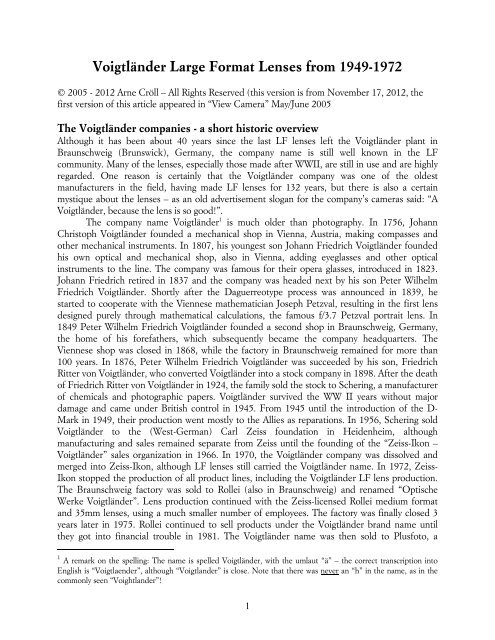
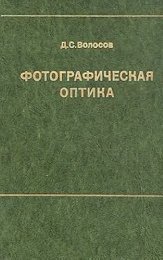
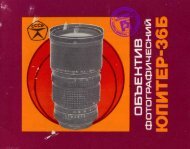

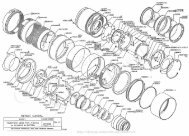



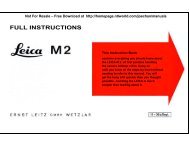
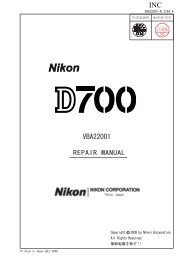
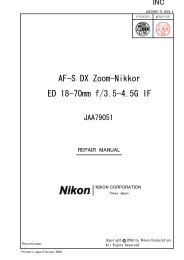
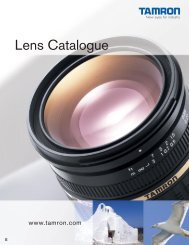

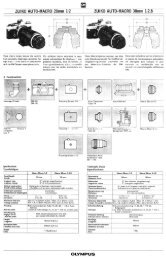

![AF 200 - 400 mm F/5.6 LD [IF] (Model 175D) - Tamron](https://img.yumpu.com/18616610/1/190x245/af-200-400-mm-f-56-ld-if-model-175d-tamron.jpg?quality=85)